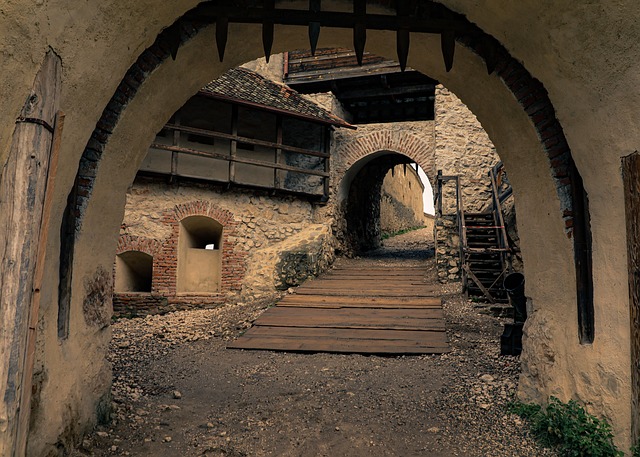Lane County's historical tapestry is woven with tales of the Gold Rush era, attracting prospectors from diverse backgrounds to its lush landscapes. Mining sites scattered across scenic valleys and mountains bear witness to their perseverance. These locations, once bustling with pickaxes and pans, now serve as monuments to Lane County prospectors' roots, inviting visitors to explore and appreciate their enduring legacy. The gold rush led to rapid transformations: vibrant towns emerged, businesses flourished, and steam-powered technologies revolutionized transportation, connecting remote sites to urban centers. Bridge construction also played a crucial role in facilitating the movement of people and goods. Today, architectural remnants from that era stand as living testaments to the county's history and the resilience of its prospectors.
“Discover the captivating legacy of Lane County, Oregon’s gold rush era, where a thriving mining culture birthed an intricate web of infrastructure. From historic mining sites that once buzzed with prospectors’ dreams to the intricate trails they blazed, this period left its mark. Explore how steam power propelled growth, bridges connected isolated communities, and unique architecture emerged. Uncover the hidden tales of gold rush towns that rose from the dust, offering a glimpse into Lane County’s rich historical landscape for intrepid explorers and curious minds.”
- Historical Lane County Mining Sites Unveiled
- Prospectors' Trails: A Network of Paths
- Gold Rush Towns: Rising from Dust
- The Role of Steam in Lane County's Boom
- Bridge Construction Connects Communities
- Legacy of Lane County's Gold Rush Architecture
Historical Lane County Mining Sites Unveiled

In the heart of Oregon’s lush landscapes, Lane County boasts a rich historical tapestry woven with threads of gold rush era exploration. Long before modern infrastructure took shape, prospectors from all walks of life flocked to these lands in search of fortune and glory. They left behind a legacy of sites that tell stories of perseverance, adventure, and the relentless human spirit.
These historical mining sites, scattered throughout Lane County’s scenic valleys and rugged mountains, offer a glimpse into the past when every stream bed was prospected, and every peak was scrutinized for its potential wealth. From humble beginning with pickaxes and pan, to more sophisticated operations employing heavy machinery, these locations have seen it all. Today, they stand as monuments to the county’s pioneering roots, inviting visitors to delve into their stories and appreciate the enduring mark left by Lane County prospectors.
Prospectors' Trails: A Network of Paths

In the heart of the Oregon Gold Rush, Lane County became a bustling hub for prospectors seeking their fortune. These intrepid explorers didn’t just stumble upon riches; they carved out intricate trails that would become the backbone of the region’s infrastructure. The network of paths, often referred to as Prospectors’ Trails, was a testament to the determination and ingenuity of these early settlers. These routes not only facilitated the movement of people but also served as vital arteries for transporting equipment, supplies, and, of course, gold.
The trails were more than just paths; they were the lifelines connecting remote mining sites with bustling towns like Eugene and Springfield. Lane County’s topography, with its rolling hills and dense forests, presented challenges that these pioneers adeptly navigated. The trails weaved through narrow passages, climbed steep slopes, and traversed lush valleys, showcasing the adaptability and resilience of those who dared to dream of striking it rich in the untamed wilderness of Oregon.
Gold Rush Towns: Rising from Dust

During the gold rush era, Lane County saw a rapid transformation as eager prospectors flocked to its rich mining grounds. Tiny settlements sprang up overnight, turning dusty patches of land into bustling towns teeming with dreamers and fortune seekers. Each community, born out of the region’s mineral wealth, became a vibrant hub of activity, offering services and refuge to the relentless miners.
These towns, like Roseburg and Sutherlin, were catalysts for social and economic growth. They provided essential supplies, accommodations, and even cultural experiences for the Lane County prospectors. The sudden surge in population led to the establishment of diverse businesses, from general stores to saloons, each contributing to the unique character and vibrancy of these gold rush-era towns.
The Role of Steam in Lane County's Boom

In the heart of the 19th century, Lane County Oregon experienced a boom fueled by gold discoveries that attracted thousands of prospectors. Among the key enablers of this influx was the advent and rapid adoption of steam-powered technologies. Steam-driven trains and boats revolutionized transportation, connecting remote mining sites to bustling towns like Eugene and Corvallis. This infrastructural shift not only facilitated the movement of goods, equipment, and people but also played a pivotal role in the county’s economic prosperity.
Prospectors, armed with pickaxes and dreams, could now access previously inaccessible areas, further enriching the region with gold discoveries. Steam-powered mills and pumps provided efficient ore processing, while steam-driven locomotives sped up the transportation of rich veins of gold from the mountains to market towns. This marriage of steam power and mining ingenuity made Lane County a hotbed of activity during the Gold Rush era, leaving an indelible mark on its historical landscape.
Bridge Construction Connects Communities

In the heart of the gold rush era, Lane County’s infrastructure underwent a transformative phase, with bridge construction playing a pivotal role in connecting communities and facilitating access for eager Lane County prospectors. These sturdy structures spanned rivers and streams, opening up new pathways and fostering economic growth. The bridges became lifelines, enabling the swift movement of people, supplies, and precious metals, which were essential for sustaining the booming mining operations.
The construction of these bridges wasn’t just about physical connections; it symbolized the county’s resilience and ambition. Local engineers and laborers toiled tirelessly to build structures that would withstand the test of time and the formidable natural forces of the region. Today, remnants of these historical bridges stand as a testament to the determination of Lane County prospectors and their impact on shaping the county’s landscape and legacy.
Legacy of Lane County's Gold Rush Architecture

Lane County’s Gold Rush era left an indelible mark on its landscape, with architecture that reflects the bustling activity and entrepreneurial spirit of the time. The legacy of Lane County prospectors is evident in the remaining structures and designs from this period. Old saloons, general stores, and mining shacks still stand as reminders of the county’s rich history. These buildings not only served practical purposes but also became cultural hubs where miners gathered to swap stories and share their findings.
The architectural styles of the time were diverse, ranging from simple log cabins to more elaborate Victorian-inspired homes. Many structures incorporated local materials like timber and stone, reflecting the region’s natural resources. Today, these historic buildings are not just relics but living testaments to the resilience and innovation of Lane County’s Gold Rush era inhabitants. They draw visitors interested in exploring the county’s past and understanding how it shaped its present.
